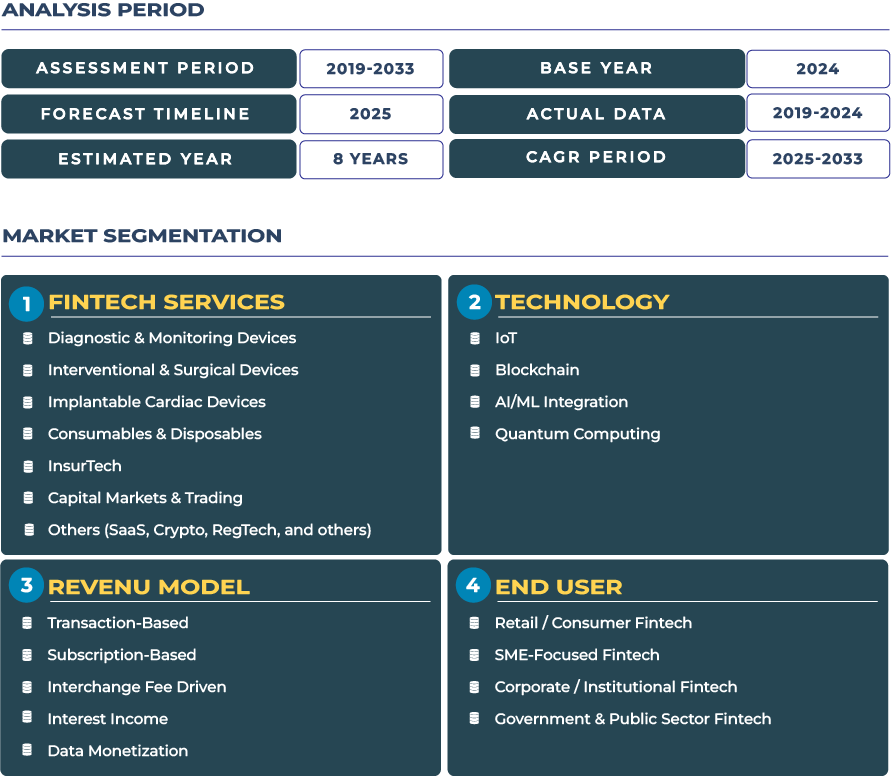Report Format:
![]()
![]() |
Pages: 110+
|
Pages: 110+
Philippines Fintech Market Outlook: Mobile-First Fintech for Diaspora Remittances: The Philippines’ Digital Finance Evolution
The Philippines is emerging as one of Southeast Asia’s most dynamic fintech ecosystems, where remittance-led, mobile-first innovations expand financial access for millions of unbanked households. With over 10 million overseas Filipino workers (OFWs) sending money home each year, digital wallets and mobile-first payment corridors have become essential lifelines for families and small enterprises. By aligning technology with remittance inflows and inclusive banking models, the fintech industry is shaping a transformative financial landscape that addresses both urban and rural needs.
Market Outlook: Diaspora-Led Inclusion Driving a High-Growth Fintech Landscape
The Philippines fintech market is projected to grow from USD 1.5 billion in 2025 to USD 8.5 billion by 2033, expanding at a CAGR of 24.4% between 2025 and 2033 (DataCube Research). This performance is underpinned by two critical forces: the scale of remittances—which reached USD 36.1 billion in 2024 according to the Bangko Sentral ng Pilipinas (BSP)—and rapid smartphone penetration exceeding 80% of the population. Mobile-first remittance services are no longer auxiliary products but the backbone of financial inclusion strategies, enabling households to access micro-savings, micro-insurance, and even payroll-linked loans. With more than 70% of adults still unbanked, wallet-based and agent-led distribution models are propelling sustainable growth across urban and rural segments.
Key Growth Drivers and Hindrances in the Philippines Fintech Industry
High remittance dependence and mobile penetration as growth catalysts: The Philippines is among the top five global remittance recipients, and fintech platforms are increasingly serving as conduits for converting these flows into structured financial services. Platforms like GCash have scaled beyond simple payments into insurance, credit, and savings, ensuring remittance-linked households can build long-term financial resilience. This remittance-first strategy is complemented by a digital-savvy youth demographic that prefers wallet-based solutions over cash-heavy alternatives.
Persistent cash reliance and fragmented KYC frameworks as barriers: Despite strong momentum, the Philippines fintech ecosystem faces hurdles. Over 35% of transactions still rely heavily on cash due to cultural habits and uneven digital infrastructure in rural areas. Moreover, fragmented ID and KYC systems, despite the rollout of the PhilSys National ID, limit onboarding efficiency for digital banks and insurtech players. These challenges slow adoption for more advanced financial services such as credit scoring and insurance underwriting.
Trends and Opportunities: Unlocking New Horizons for Inclusive Finance
Agent Banking and Mobile Wallet Growth
Mobile-first banking is gaining traction through agent-led expansion in rural regions. Partnerships with sari-sari stores and local cooperatives extend financial services beyond major cities like Manila and Cebu. Digital wallets now integrate with payroll, micro-lending, and bill payments, creating holistic platforms that align with both urban consumers and underserved provinces.
Remittance-to-finance Conversion and Rural Micro-Insurance
Remittance corridors are increasingly tied to financial products. Families receiving overseas remittances are now offered bundled micro-savings and micro-insurance products directly through digital wallets. This model is helping rural populations hedge risks related to health, agriculture, and education costs while gradually shifting them away from cash-only dependence.
Regulatory Framework: The Role of BSP in Enabling Market Expansion
The Bangko Sentral ng Pilipinas (BSP) plays a pivotal role in shaping the fintech industry by regulating e-money issuers, digital banks, and payment systems. Initiatives such as the Digital Payments Transformation Roadmap aim to transition 50% of retail payments to digital by 2026 while ensuring financial inclusion for 70% of adults. BSP’s regulatory push through systems like and InstaPay is critical for scaling remittance flows into formalized financial channels. Regulatory clarity is also being extended to digital lending, neobanks, and insurtech—areas witnessing rapid innovation.
Key Impacting Factors: From Diaspora Transfers to Mobile Wallet Uptake
Several macroeconomic and structural factors define the trajectory of the Philippines fintech market. Remittance inflows provide steady foreign currency inflows that sustain demand for low-cost fintech corridors. Meanwhile, monthly active users (MAUs) of mobile wallets such as GCash and Maya have crossed 80 million in 2024, demonstrating mass adoption. However, challenges such as inflationary pressures, geopolitical uncertainty in labor destinations (e.g., Middle East), and cybersecurity risks remain critical considerations for long-term market resilience.
Competitive Landscape: Innovation, Partnerships, and Expanding Market Strategies
The competitive landscape is shaped by a blend of domestic leaders and international entrants. GCash and Maya dominate the mobile-first fintech ecosystem, while global players like Wise are deepening their foothold. In August 2025, Wise became the first global fintech fully integrated with both InstaPay and PESONet, now processing ~12% of inward personal remittances. This signals a shift toward interoperable platforms that lower transaction costs and expand choice for consumers. At the same time, new digital bank license expansions in 2025 have opened opportunities for both local and regional entrants to offer specialized products such as SME lending and diaspora-linked micro-insurance.
Strategically, fintech firms are focusing on rural financial inclusion, product diversification (insurance, credit, and micro-savings), and compliance upgrades. Following a cyber incident targeting national credit data in neighboring markets, Philippine firms are also prioritizing cybersecurity and national ID integration to maintain consumer trust.
Conclusion: The Philippines at the Intersection of Remittance and Digital Finance
The Philippines fintech market is uniquely positioned at the intersection of remittance inflows and mobile-first adoption. This dual force not only sustains its high growth momentum but also aligns with inclusive development goals. By leveraging remittance corridors, mobile wallets, and government-backed payment infrastructure, fintech platforms are creating new pathways for unbanked and underbanked communities. The country’s strategic focus on regulatory innovation, rural agent banking, and diaspora-linked insurance products signals a future where fintech becomes a catalyst for financial stability, resilience, and economic participation. While challenges around KYC integration, cash dependence, and cybersecurity risks persist, the market’s adaptability and innovation capacity remain robust. For investors, regulators, and entrepreneurs, the Philippines represents one of the most promising fintech landscapes in Asia.







